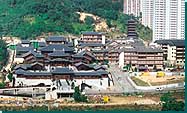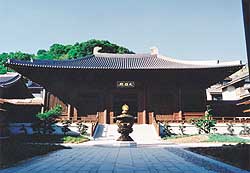| May
2000 |

Traditional carpentry tools were
used
in the construction process

|
|
|
Chi Lin Nunnery
Grand recreation
Historians and patriots
talk about the great Chinese civilisation, which has produced so
many inventions and spectacular relics. How much more would they
be able to enthuse about if so much had not been lost through the
ages? Ancient Chinese architecture, with its emphasis on harmony
with nature, was one of those losses until recently, when a concerted
effort by devotees and a team of architects and builders led to
a full-scale recreation of a Tang Dynasty temple complex in the
form of the Chi Lin Nunnery at Diamond Hill
 The
effort was by no means easy. There are similar temples in Japan
and one example at a temple in Shaanxi, but a monastic complex of
the scale and grandeur conceived for Chi Lin only existed in ancient
Dunhuang paintings. Chi Lin involved the creation of a 180,000 sq
ft complex consisting of 15 halls. There are nine ancient timber
structures and three reinforced concrete structures. Facilities
such as the bell and drum towers; the Hall of Celestial Kings; the
Ten Thousand Buddhas Pagoda; an ancestral hall; a scripture library;
a prayer hall; and the Dharma Hall are complemented by landscaped
gardens designed in accordance with ancient architectural principles. The
effort was by no means easy. There are similar temples in Japan
and one example at a temple in Shaanxi, but a monastic complex of
the scale and grandeur conceived for Chi Lin only existed in ancient
Dunhuang paintings. Chi Lin involved the creation of a 180,000 sq
ft complex consisting of 15 halls. There are nine ancient timber
structures and three reinforced concrete structures. Facilities
such as the bell and drum towers; the Hall of Celestial Kings; the
Ten Thousand Buddhas Pagoda; an ancestral hall; a scripture library;
a prayer hall; and the Dharma Hall are complemented by landscaped
gardens designed in accordance with ancient architectural principles.
The buildings are also
disposed according to the orientation principles of classic Chinese
architecture. That means having a south-facing complex set against
a backdrop of mountains to the north, with buildings distributed
along an east-west axis. All the important or ceremonious halls
are situated in the east while halls for more private functions,
such as an ancestral hall and utilities for the devoted, are situated
in the west. Windows set in the eastern facades are set at an angle
to deflect solar glare and soften the impact of the wind, while
a lotus pond in the south is strategically placed so that it can
fill the complex with its becalming fragrance in the summer as the
smell of fresh lotus floats through the air on a southeasterly breeze.
In order to recreate Tang
Dynasty architecture, the combined skills of historical researchers,
experts from Tsinghua University and craftsmen from Japan as well
as various parts of China were deployed.
According to Yu Leung,
senior manager (contracts) of Hip Hing Construction, which was main
contractor and project manager for the project, a draft of the buildings
was drawn up based upon details in the Dunhuang paintings. A construction
team from Beijing was then brought in to work out the structural
configuration. Scale models were used to determine the soundness
of ancient structural timber assembly.
A Japanese specialist
from Nara who is the sixth generation to be involved in the restoration
and construction of ancient buildings was invited to teach the whole
team how to build an ancient temple. In addition to teaching the
craftsmen how to build the structure, he also gave them tips as
to where things were most likely to break down, what were likely
to need restoration and how long the structure could be expected
to last.
Then came the challenge
of finding the timber for a structure which would testify to the
glory of ancient Chinese architecture for years to come.
Traditionally, Chinese
temples were built using locally available timber. This, of course,
was completely out of the question in modern, urban Hong Kong. Intead,
timber was sourced from China, the US, Canada and Africa.
The type of timber used
most extensively on this project is yellow cedar from Canada, which
was selected for its light weight, flexibility, pleasant aroma and
insect-repelling properties. In order to obtain best results from
the timber, natural treatment methods were adopted, with the timber
being soaked and wind-dried rather than kiln-dried. According to
Mr Yu, a total of 228,000 pieces of timber were used for this project.
The timber frames support
roofs which were designed with the nunnery's
location in a southern region in mind. The need to cope with rain
rather than snow is reflected in the curved eaves, which allow water
to fall off gently. Northern structures would have featured straight,
sloped eaves designed to unload snow, according to Mr Yu.
About 350,000 pieces of
roof tiles made by traditional methods in Nara were imported for
the project. Although they were made in Japan, Mr Yu said they were
all based on ancient Tang designs. Due to the humid weather in Hong
Kong, the tiles were installed with a dry method instead of mud.
Mr Yu said tying the tiles together with wires makes it easier to
replace them in the future. At the same time, wires do not absorb
water or attract ants like mud does, so the dry installation method
would help prolong the structure's life.
Although modern systems
and techniques were used, for example to protect the complex from
fire through a sprinkler system; traditional methods were followed
as much as possible. Thus, the timber structures were constructed
using traditional bracketing, which does not require nails or bolts.
Each intricate bracket is made up of numerous interlocking components,
with the simplest brackets having a dozen components and the complex
corner brackets about 100 components. For an idea of the complexity
involved, the bracketing system for the 4,000 sq ft main hall has
6,000 components in eight layers.
Similarly, a traditional
waterproofing method using bark was preferred to modern waterproofing
methods. Apparently the traditional method would work better than
a modern one, because bark would allow the timber to breathe.
Chi Lin Nunnery has been
built to last at least 500 years. In order to facilitate maintenance
as well as to ensure that details of how to build such a Tang Dynasty
complex will not be lost again, Hip Hing has prepared extensive
documents listing all materials and maintenance procedures. For
example, a log book has been compiled listing all the details about
every piece of timber used, including type, dimension, purpose and
exact location. Each piece of timber even has its own identification
number.
The complex is expected
to thrive in a natural setting where living flora and fauna provide
a nurturing atmosphere for the timber structures. One hopes the
air pollution which has dogged Hong Kong in recent years will not
spoil the beauty or longevity of this masterpiece.
client Chi Lin Nunnery
architect Don Pan & Associates
main contractor Hip Hing Construction
|

 The
effort was by no means easy. There are similar temples in Japan
and one example at a temple in Shaanxi, but a monastic complex of
the scale and grandeur conceived for Chi Lin only existed in ancient
Dunhuang paintings. Chi Lin involved the creation of a 180,000 sq
ft complex consisting of 15 halls. There are nine ancient timber
structures and three reinforced concrete structures. Facilities
such as the bell and drum towers; the Hall of Celestial Kings; the
Ten Thousand Buddhas Pagoda; an ancestral hall; a scripture library;
a prayer hall; and the Dharma Hall are complemented by landscaped
gardens designed in accordance with ancient architectural principles.
The
effort was by no means easy. There are similar temples in Japan
and one example at a temple in Shaanxi, but a monastic complex of
the scale and grandeur conceived for Chi Lin only existed in ancient
Dunhuang paintings. Chi Lin involved the creation of a 180,000 sq
ft complex consisting of 15 halls. There are nine ancient timber
structures and three reinforced concrete structures. Facilities
such as the bell and drum towers; the Hall of Celestial Kings; the
Ten Thousand Buddhas Pagoda; an ancestral hall; a scripture library;
a prayer hall; and the Dharma Hall are complemented by landscaped
gardens designed in accordance with ancient architectural principles.